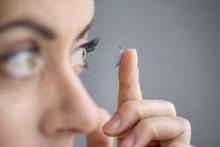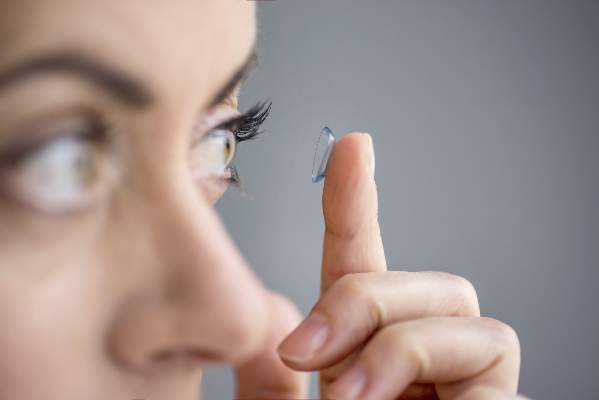User login
Nearly 1 million visits to physicians’ offices, outpatient clinics, and emergency departments occur every year that are directly related to keratitis or other contact lens–related disorders, at a cost of millions of dollars in direct health care expenditures, according to a new study released Nov. 14 by the Centers for Disease Control and Prevention.
“Here at CDC, we’ve long suspected that keratitis poses a significant burden on Americans’ health and on our health care system, both in individual cases and in periodic, multistate outbreaks associated with contact lens wearers,” Dr. Jennifer Cope, a CDC medical epidemiologist, said in a telebriefing. “But until now, we didn’t have any estimates as to how large that burden might be.”
According to an analysis of 2010 data from three national ambulatory care and emergency department databases, the CDC estimated that keratitis and other contact lens–related disorders cost Americans $175 million in direct healthcare costs each year, including $58 million for Medicare patients and $12 million for Medicaid patients. Of the nearly 1 million healthcare visits related to keratitis and other contact lens–related disorders, roughly 930,000 were to physicians’ offices and outpatient clinics, while around 58,000 were to emergency departments, ultimately accounting for 250,000 clinician hours yearly (MMWR 2014:63:1027-30).
The CDC study indicated that 76.5% of keratitis-related health care visits every year result in prescriptions for antimicrobial agents. Separately, another roughly 230,000 visits to clinicians’ offices or outpatient clinics for corneal disorders every year are related to use of contact lenses, and 70% of those require antimicrobial prescriptions. In an effort to increase public awareness of contact lens disorders ahead of its “Contact Lens Health Week,” which runs from Nov. 17 to 21, the CDC is warning the nearly 38 million American contact lens wearers to practice good lens hygiene to ensure that they do not develop keratitis, which is known to lead to partial or complete loss of vision in many cases.
“Wearing contacts and not taking care of them properly is the single largest risk factor for [developing] keratitis,” said Dr. Cope. “Some bad habits, like sleeping in your contact lenses, failing to clean and replace your storage case frequently, and letting contact lenses get in water – whether you’re swimming, showering, or rinsing the lenses in water instead of in contact lens solution – greatly increase a person’s risk for developing keratitis.”
The CDC recommends washing your hands with soap and water before putting contact lenses into your eyes in order to mitigate the chances of introducing bacteria into your eyes while touching them, putting fresh contact lens solution into your storage case daily, replacing contact lens cases every 3 months, and never sleeping in your contact lenses unless explicitly advised to by your doctor.
“People who wear their contact lenses overnight are more than 20 times more likely to get keratitis,” Dr. Cope noted, adding that “Contact lenses can provide many benefits, but they are not risk-free.”
More information on the CDC’s contact lens “Wear and Care” guidelines can be found at the CDC website.
Nearly 1 million visits to physicians’ offices, outpatient clinics, and emergency departments occur every year that are directly related to keratitis or other contact lens–related disorders, at a cost of millions of dollars in direct health care expenditures, according to a new study released Nov. 14 by the Centers for Disease Control and Prevention.
“Here at CDC, we’ve long suspected that keratitis poses a significant burden on Americans’ health and on our health care system, both in individual cases and in periodic, multistate outbreaks associated with contact lens wearers,” Dr. Jennifer Cope, a CDC medical epidemiologist, said in a telebriefing. “But until now, we didn’t have any estimates as to how large that burden might be.”
According to an analysis of 2010 data from three national ambulatory care and emergency department databases, the CDC estimated that keratitis and other contact lens–related disorders cost Americans $175 million in direct healthcare costs each year, including $58 million for Medicare patients and $12 million for Medicaid patients. Of the nearly 1 million healthcare visits related to keratitis and other contact lens–related disorders, roughly 930,000 were to physicians’ offices and outpatient clinics, while around 58,000 were to emergency departments, ultimately accounting for 250,000 clinician hours yearly (MMWR 2014:63:1027-30).
The CDC study indicated that 76.5% of keratitis-related health care visits every year result in prescriptions for antimicrobial agents. Separately, another roughly 230,000 visits to clinicians’ offices or outpatient clinics for corneal disorders every year are related to use of contact lenses, and 70% of those require antimicrobial prescriptions. In an effort to increase public awareness of contact lens disorders ahead of its “Contact Lens Health Week,” which runs from Nov. 17 to 21, the CDC is warning the nearly 38 million American contact lens wearers to practice good lens hygiene to ensure that they do not develop keratitis, which is known to lead to partial or complete loss of vision in many cases.
“Wearing contacts and not taking care of them properly is the single largest risk factor for [developing] keratitis,” said Dr. Cope. “Some bad habits, like sleeping in your contact lenses, failing to clean and replace your storage case frequently, and letting contact lenses get in water – whether you’re swimming, showering, or rinsing the lenses in water instead of in contact lens solution – greatly increase a person’s risk for developing keratitis.”
The CDC recommends washing your hands with soap and water before putting contact lenses into your eyes in order to mitigate the chances of introducing bacteria into your eyes while touching them, putting fresh contact lens solution into your storage case daily, replacing contact lens cases every 3 months, and never sleeping in your contact lenses unless explicitly advised to by your doctor.
“People who wear their contact lenses overnight are more than 20 times more likely to get keratitis,” Dr. Cope noted, adding that “Contact lenses can provide many benefits, but they are not risk-free.”
More information on the CDC’s contact lens “Wear and Care” guidelines can be found at the CDC website.
Nearly 1 million visits to physicians’ offices, outpatient clinics, and emergency departments occur every year that are directly related to keratitis or other contact lens–related disorders, at a cost of millions of dollars in direct health care expenditures, according to a new study released Nov. 14 by the Centers for Disease Control and Prevention.
“Here at CDC, we’ve long suspected that keratitis poses a significant burden on Americans’ health and on our health care system, both in individual cases and in periodic, multistate outbreaks associated with contact lens wearers,” Dr. Jennifer Cope, a CDC medical epidemiologist, said in a telebriefing. “But until now, we didn’t have any estimates as to how large that burden might be.”
According to an analysis of 2010 data from three national ambulatory care and emergency department databases, the CDC estimated that keratitis and other contact lens–related disorders cost Americans $175 million in direct healthcare costs each year, including $58 million for Medicare patients and $12 million for Medicaid patients. Of the nearly 1 million healthcare visits related to keratitis and other contact lens–related disorders, roughly 930,000 were to physicians’ offices and outpatient clinics, while around 58,000 were to emergency departments, ultimately accounting for 250,000 clinician hours yearly (MMWR 2014:63:1027-30).
The CDC study indicated that 76.5% of keratitis-related health care visits every year result in prescriptions for antimicrobial agents. Separately, another roughly 230,000 visits to clinicians’ offices or outpatient clinics for corneal disorders every year are related to use of contact lenses, and 70% of those require antimicrobial prescriptions. In an effort to increase public awareness of contact lens disorders ahead of its “Contact Lens Health Week,” which runs from Nov. 17 to 21, the CDC is warning the nearly 38 million American contact lens wearers to practice good lens hygiene to ensure that they do not develop keratitis, which is known to lead to partial or complete loss of vision in many cases.
“Wearing contacts and not taking care of them properly is the single largest risk factor for [developing] keratitis,” said Dr. Cope. “Some bad habits, like sleeping in your contact lenses, failing to clean and replace your storage case frequently, and letting contact lenses get in water – whether you’re swimming, showering, or rinsing the lenses in water instead of in contact lens solution – greatly increase a person’s risk for developing keratitis.”
The CDC recommends washing your hands with soap and water before putting contact lenses into your eyes in order to mitigate the chances of introducing bacteria into your eyes while touching them, putting fresh contact lens solution into your storage case daily, replacing contact lens cases every 3 months, and never sleeping in your contact lenses unless explicitly advised to by your doctor.
“People who wear their contact lenses overnight are more than 20 times more likely to get keratitis,” Dr. Cope noted, adding that “Contact lenses can provide many benefits, but they are not risk-free.”
More information on the CDC’s contact lens “Wear and Care” guidelines can be found at the CDC website.
FROM MMWR

